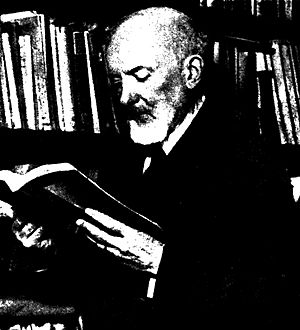Georges Lefebvre facts for kids
Georges Lefebvre (born August 6, 1874 – died August 28, 1959) was a French historian. He is most famous for his studies on the French Revolution and the lives of peasants. Lefebvre was one of the first historians to focus on "history from below." This means he looked at how ordinary people, especially peasants, shaped big events. He called the "Great Fear" of 1789 the "death certificate of the old order." One of his most important books was Les Paysans du Nord pendant la Révolution française (which means "The Peasants of the North During the French Revolution"). He spent 20 years researching this book, which was published in 1924.
Contents
Early Life and Education
Georges Lefebvre was born in Lille, France. His family did not have much money. He went to public school and got scholarships to help him through high school and university. At the University of Lille, he studied modern languages, math, and economics. This was different from the usual focus on classical languages.
After graduating in 1898, Lefebvre taught in high schools for over twenty years. Later, he started teaching at universities. Around the time of World War II, he became very interested in Marxism. This idea suggests that history is shaped by how societies are organized economically and by the relationships between different social classes. He passed away in Paris in 1959.
Studying the French Revolution
Lefebvre started writing in 1904. But it wasn't until 1924, when he was 50, that he finished his main university paper. This paper was called Les Paysans du Nord pendant la Révolution française. It was a very detailed study of how the French Revolution affected the countryside.
To write this paper, Lefebvre looked at thousands of old tax records and other official documents. He used these to understand how the end of feudalism and church taxes changed things for peasants. He also studied how property changed hands and how city people moved into the countryside.
Lefebvre often wrote from the point of view of the peasants of that time. In his book "The Coming of the French Revolution," he said four main groups played a part:
- The rich nobles, who stopped the king from making changes.
- The middle class (bourgeoisie).
- The city people, who started the revolution by storming the Bastille.
- The peasants, who also had their own revolution.
Many historians study Lefebvre's writings from 1924 to 1959. During this time, he offered a much deeper understanding of the Revolution than other historians. Historian Peter Jones pointed out three key ideas from Lefebvre:
- Peasants in the countryside were very active in the Revolution.
- Their actions were not mainly controlled by the middle class.
- Peasants mostly agreed on an anti-capitalist way of thinking in the 1790s.
Key Works and Achievements
Lefebvre's book Quatre-Vingt-Neuf (meaning '89) explained how the French Revolution began. It was published in 1939 to mark 150 years since the events of 1789. However, the Vichy government, which took over France the next year, did not like his left-wing view of the Revolution. They ordered 8,000 copies of the book to be burned. Because of this, the book was almost unknown in France until it was reprinted in 1970.
But in English-speaking countries, the book was already famous. Its English translation, The Coming of the French Revolution (1939), was seen as a clear and important book. It is still considered a key explanation of the Marxist view of the Revolution's causes.
His major work, La Révolution Française (a revised edition came out in 1951), was translated into English in two parts: The French Revolution From Its Origins To 1793 (1962-1964) and The French Revolution from 1793 to 1799 (1964). He also wrote a highly respected study of Napoléon (translated into two volumes in 1969).
A study by Lawrence Davis looked at the later part of Lefebvre's life. Davis talked about Lefebvre's idea of mentalité. This term means the shared way of thinking and feeling among a group of people in the past. Lefebvre used this idea to explain the peasants' actions during the Revolution.
Recognition and Later Life
In 1935, Georges Lefebvre became the president of the Societé des Études Robespierristes. He also became the director of the Annales historiques de la Révolution française, an important history journal. In 1937, Lefebvre was given the special role of Chair of the History of the French Revolution at the Sorbonne University in Paris.
He had already published a collection of historical documents in 1914. Lefebvre continued to write about the French Revolution even after he retired from the Sorbonne in 1945. Georges Lefebvre passed away on August 28, 1959.
Selected works
- La Grande Peur de 1789 (1932), translated by Joan White as The Great Fear of 1789: Rural Panic in Revolutionary France (Pantheon, 1973).
- Les Thermidoriens (1937).
- Le Directoire (1946).
- The Thermidorians and the Directory: Two Phases of the French Revolution, translated by Robert Baldick (Random House, 1964).
- Quatre-Vingt-Neuf (1939), translated by R. R. Palmer as The Coming of the French Revolution (Princeton University Press, 1947; bicentennial edition, 1989).
- Napoléon (1935); Volume I translated by Henry F. Stockhold as Napoleon: From 18 Brumaire to Tilsit, 1799-1807 and Volume II translated by J. E. Anderson as Napoleon: From Tilsit to Waterloo, 1807-1815 (Columbia University Press, 1969).
- La Révolution Française (Volume I, 1951), translated by Elizabeth Moss Evanson as The French Revolution: From Its Origins to 1793 (Columbia University Press, 1962).
- La Révolution Française (Volume II, 1957), translated by John Hall Stewart and James Friguglietti as The French Revolution: From 1793 to 1799 (Columbia University Press, 1964).
See also
 In Spanish: Georges Lefebvre para niños
In Spanish: Georges Lefebvre para niños


